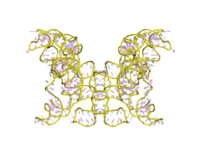Group I catalytic intron
| Group I catalytic intron | |
|---|---|
| SO | SO:0000587 |
| PDB structures | PDBe |
Group I introns are large self-splicing
Catalysis

Two-metal-ion mechanism seen in protein



Intron folding
Since the early 1990s, scientists started to study how the group I intron achieves its native structure
Distribution, phylogeny and mobility
Group I introns are distributed in bacteria, lower eukaryotes and higher plants. However, their occurrence in bacteria seems to be more sporadic than in lower eukaryotes, and they have become prevalent in higher plants. The genes that group I introns interrupt differ significantly: They interrupt
Group I introns are also found inserted into genes of a wide variety of
Both intron-early and intron-late theories have found evidences in explaining the origin of group I introns. Some group I introns encode homing endonuclease (HEG), which catalyzes intron mobility. It is proposed that HEGs move the intron from one location to another, from one organism to another and thus account for the wide spreading of the selfish group I introns. No biological role has been identified for group I introns thus far except for splicing of themselves from the precursor to prevent the death of the host that they live by. A small number of group I introns are also found to encode a class of proteins called maturases that facilitate the intron splicing.
See also
- Intron
- Group I Intron Sequence and Structure Database
- Splice site
- Nuclear introns
- Group II intron
- Group III intron
- Twintron
- LtrA
- Cyclic di-GMP-II riboswitch, where there is an example of a riboswitch acting together with a group I intron to regulate the expression of a gene
References
Further reading
- Chauhan, S; Caliskan G; Briber RM; Perez-Salas U; Rangan P; Thirumalai D; Woodson SA (2005). "RNA tertiary interactions mediate native collapse of a bacterial group I ribozyme". J Mol Biol. 353 (5): 1199–1209. PMID 16214167.
- Haugen, P; Simon DM; Bhattacharya D (2005). "The natural history of group I introns". Trends in Genetics. 21 (2): 111–119. PMID 15661357.
- Rangan, P; Masquida, B; Westhof E; Woodson SA (2003). "Assembly of core helices and rapid tertiary folding of a small bacterial group I ribozyme". Proc Natl Acad Sci USA. 100 (4): 1574–1579. PMID 12574513.
- Schroeder, R; Barta A; Semrad K (2004). "Strategies for RNA folding and assembly". Nat Rev Mol Cell Biol. 5 (11): 908–919. S2CID 22030359.
- Thirumalai, D; Lee N; Woodson SA; Klimov D (2001). "Early events in RNA folding". Annu Rev Phys Chem. 52: 751–762. PMID 11326079.
- Treiber, DK; Williamson JR (1999). "Exposing the kinetic traps in RNA folding". Curr Opin Struct Biol. 9 (3): 339–345. PMID 10361090.
- Xiao, M; Leibowitz MJ; Zhang Y (2003). "Concerted folding of a Candida ribozyme into the catalytically active structure posterior to a rapid RNA compaction". Nucleic Acids Res. 31 (14): 3901–3908. PMID 12853605.
